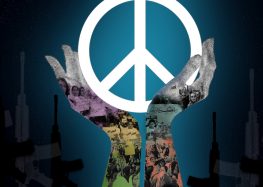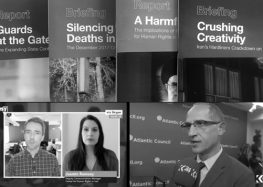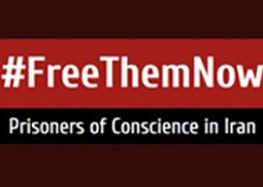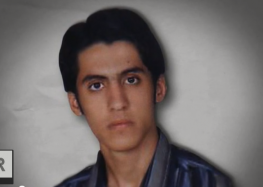Regulatory Framework for Denial of Education
Next Section: International Law
Back to table of contents
University Admission and Entrance Exams
Iranians who want to attend a government university program (at the undergraduate or graduate level) must complete secondary school and take an entrance exam known as the concour.1 The concour is administered once a year in the spring by the Sanjesh Organization, the Ministry of Science’s academic measurement bureau, and is the sole academic criteria for admission to institutions of higher education.2
Exam takers must also fill out an application form that asks for basic biographic and educational data.3 Test takers also select their academic major and degree and register for the corresponding exam.
Applicants are rejected or accepted to government universities based on the scores and rankings they receive on the entrance exam. As the number of test takers outstrips the number of available university seats, the exam and admissions process is highly competitive. According to Sanjesh organization, out of 1,286,813 participants in the nationwide 2010 entrance exam, 517,068 were admitted, a rate of 40.1%. Government universities are generally elite schools. Seats are highly coveted at the best government schools, including the University of Tehran, Sharif University of Technology, Amirkabir University of Technology and Shahid Beheshti University, as well as universities in major cities such as Shiraz, Isfahan, and Tabriz. The government has also adopted a quota system that sets aside quotas for applicants from special social groups such as family members of war veterans and Basij voluntary militia.
Results of the concour are released a few months after the test’s administration. The names and rankings of applicants who passed the exam are widely publicized, as they are published in newspapers and on the Sanjesh website. Students are allowed special access to more thorough test results online. Applicants that pass the exams visit the Sanjesh website and rank, in order of preference, the universities they want to attend.
Regulations Permitting Screening and Exclusion
Two regulations issued by the Supreme Council of the Cultural Revolution empower the Central Selection Committee at the Ministry of Science to disqualify graduate school candidates: the Moral Selection Regulations for University Entrance Applicants, which was ordered on 5 January 1987, by then-president Ali Khamenei, who headed this council; and the Student Selection Criteria, adopted by the Supreme Council of the Cultural Revolution on 7 June 1988.4
Under the Moral Selection Regulations, “determination of moral qualification is the responsibility of the Central Selection Committee, which is under direct supervision by the Minister of Culture and Higher Education. This Committee is appointed by the Supreme Council of the Cultural Revolution,” and “the [Minister of Science] is required to inform the Supreme Council of the Cultural Revolution of its activities on a regular basis.”5
The Moral Selection Regulations require that academic questions in university entrance examinations include ideological, political, and moral questions, and in response to these questions, exam participants must earn passing scores.6 Furthermore, the “moral and political backgrounds of the exam participants must be investigated [and documented], in writing, by the [Ministry of Science], Prosecutor General and Revolutionary Courts, and Ministry of Intelligence.” The Student Selection Criteria, however, prohibits these government bodies from conducting background investigations at a candidate’s residence or place of work, or by interviewing his or her neighbors.7
The Moral Selection Regulations stipulate that:
After registration, information from all university applicants, the names of those accepted, and the names of an [additional] 10% to 15% of applicants on the admissions waitlist, must immediately be submitted to five [governmental] bodies for investigation and verification [that they meet] necessary requirements, as outlined by the Supreme Council of the Cultural Revolution.8
The names of final term high school students, who have taken the exam, are first sent to the relevant branches of the Ministry of Education, “so any student who is reputed to be morally corrupt, etc. is identified in advance,” and the Central Selection Committee is informed of it.9
Next the names are sent to the Ministry of Intelligence, Prosecutor General, the Judiciary, and the Research Documents Center to inquire about the entrance exams from previous years.10
Under the Moral Selection Regulations for University Entrance Applicants,
If these five organizations do not provide any negative reports about an applicant, then enrollment of the applicant into the university is permissible, unless documented negative reports from other reliable sources have been filed.11
The files of applicants who receive at least one negative report, whether from the five bodies or “other reliable sources,” are sent to the Central Selection Committee, where “the final verdict of admission, or prevention thereof, for these university applicants must be issued by the Committee’s Judge, after review by Central Selection Committee.”12
Under the Student Selection Criteria:
Those who meet any of the following criteria will be deprived from entering the university:
A) Those addicted to drugs.
B) Those who are reputed to be morally corrupt.
C) Enemies of the Islamic Republic (but not critics).13
The regulations make clear that a reputation of moral corruption “must be obvious and without need for investigation,” and explicitly differentiates between “critics” and “enemies” of the state.14
The Central Selection Committee can also give some candidates “conditional permission for education.”15 Some candidates are also “accepted to universities under their own recognizance.” The regulations require that candidates about “whom the Ministry of Intelligence or legal authorities have given reports of moral corruption or political activities, must give guarantees to reform their behavior upon admission to universities.”16
The Student Selection Criteria notes that to the extent possible, “efforts must be made so that the number of these kinds of individuals will not become too great, so the issue of giving guarantees will not lose its significance.”17
The Administrative Starring Process and the Role of Security Organizations
According to Morteza Noorbakhsh, director of Central Selection Committee, the process of starring begins when the Sanjesh Organization sends the Central Selection Committee a CD containing the names of all university applicants, along with a list of those who passed the entrance exam. The total number of applicants is equivalent to roughly 1.5 to 2 times the admission capacity for each degree program.
As Noorbakhsh explains:
This CD is presented to the relevant authorities [i.e. the Ministry of Intelligence, Revolutionary Courts, Ministry of Education, Prosecutor General and the Research Documents Center] to review the student’s general qualifications and to provide their decision. … [N]ext to each student’s name, there will appear a code from 0 to 5. These codes will define these students’ status to the Sanjesh Organization.18
Noorbakhsh clarifies that “Code 1 is indicative of the applicant’s rejection, Codes 0 and 2 mean incomplete file, Codes 3 and 4 mean acceptance, and Code 5 means student recognizance required.”
He explained that Code 1 candidates are rejected on the basis of negative reports from the Ministry of Intelligence or the courts. As former Minister of Science Mohammad Mehdi Zahedi put it, “This means that according to the relevant authorities, this group of individuals is not qualified to enter the universities.”
According to Noorbaksh, the names of these individuals are never publicly reported and they are barred from higher education.
Noorbakhsh explained that Codes 0, 2 and 5 are markers used by the Central Selection Committee, but the Sanjesh Organization simplifies the system by using one and two stars.
Some starred students are able to object and appeal the decision, and could gain admission after signing a recognizance letter. In this letter, the student must promise to cease engaging in the activities deemed by the Ministry of Intelligence or other government agencies to be grounds for disqualification.
According to Noorbakhsh, these students should also acknowledge that “the authorities are allowed to deprive them from continuing their education, should they see any ‘movement,’ and the student would be obligated to re-pay the university’s costs.”
Regulations of Disciplinary Committees
The disciplinary committees are charged with investigating student misconduct and are empowered to hand down punishments. According to the Disciplinary Regulations for University Students in the Islamic Republic of Iran, the purview of the disciplinary committees covers a broad range of offenses including criminal, educational and administrative, political, and moral offenses.19 Among the political offenses defined in the Regulations are “insulting Islamic and national beliefs and committing actions against the Islamic Republic (such as writing slogans, distributing announcements)” and “providing false information intentionally.”20
The committees can order punishments that include suspending students from the university, expelling students, and even banning students from education in all universities for up to five years.21
The composition of the committees is determined by the university administration. In each university, the disciplinary committee has five voting members: a representative of Supreme Leader of Iran Ayatollah Khamenei, the dean of students, a member of the faculty appointed by the university president, and two students also appointed by the university president; there is also a non-voting committee secretary. Committee decisions require a simple majority.22
Regulations Regarding Student’s Religious Beliefs
The Moral Selection Regulations for University Entrance Applicants explicitly requires university students to profess belief either in Islam or other recognized religions in the Iranian Constitution (Christianity, Judaism, and Zoroastrianism). Article A of these regulations explicitly forbids students who believe in other religions from having access to higher education:
Students who have the right to enter universities, in addition to passing the entrance examinations, must also fulfill the following requirements:
1- Belonging to Islam or other recognized religions.
Note1: Determination of their belief is based on their own statements and no one has the right to inquisition or to investigate their beliefs.
Note 2: Whenever a student applicant for entry to university claims to be a Muslim or belong to other recognized religions, his/her claim will be accepted unless in a qualified court of law the opposite is proven. In such a case the right of this person to education at a university will be taken away and does not have the right to continue his/her education.
In February 1991, the Supreme Council of the Cultural Revolution issued a set of recommendations for government agencies in dealing with Baha’is.23 The Council instructed authorities to block the “progress and development” of Baha’is in Iran. The recommendations state that Baha’is “can be enrolled in schools provided they have not identified themselves as Baha’is,” but “they must be expelled from universities, either in the admission process or during the course of their studies, once it becomes known that they are Baha’is.”
————————————————————




